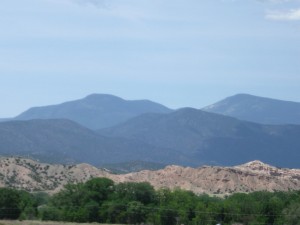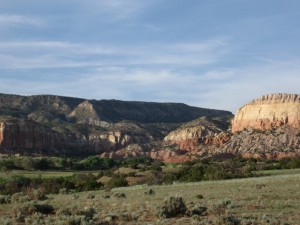
We awoke at the Mabel Dodge Luhan House in Taos and headed out towards Santa Fe. On the way, I stopped to shoot some film of the Rio Grande river and surrounding hills. We also pulled over by Alcalde, the town where Georgia O’Keeffe had stayed on a ranch in her early visits to New Mexico and painted views of the Jemez mountains. I snapped a photo that shows approximately the same view as her painting “Black Mesa Landscape / Out Back of Marie’s II”.
We eventually made our way to Santa Fe and went straight to the “Abstraction” exhibit at the Georgia O’Keeffe Museum (co-organized with the Whitney Museum in New York and the Phillips Collection in Washington, DC), which was wonderful. The textual curation was limited to some interesting quotations from O’Keeffe herself, which shed some light on her attitude towards the art on view. The works spanned the length of her career, from her early minimalist watercolors (see “Black Lines”) to late bronze cast works (see “Abstraction”). The exhibit encompassed “purely” abstract pieces, such as “Music ”“ Pink and Blue II”, as well as works that blend the line between abstract and representational, like “Pelvis Series, Red with Yellow”, the least literal in her group of paintings in which magnified animal bones frame views of the sky. And of course, the exhibit also featured some of O’Keeffe’s abstracted landscapes.
I found the series of jack-in-the-pulpit paintings particularly beautiful and interesting, displaying clearly how O’Keeffe would start with a quasi-realistic representation of an isolated subject (see Jack-in-Pulpit – No. 2), and transform it into increasingly abstracted images (see Jack-in-Pulpit – No. 5) , like fantasias on the shapes and colors that she saw in the original subject.
There is a certain feature of these works that is essentially imperceptible when viewing reproductions in a book or poster. Generally speaking, the largest of O’Keeffe’s paintings tend to show her most simplified images (see “Sky With Flat White Cloud”) , while the smaller paintings often feature much more delicate and detailed subjects (see “The Black Iris”) . It seems to me that the bolder the image, the larger it needs to be in order to be really seen ”“ it was O’Keeffe’s way of throwing the viewer into her vision. (In a famous quote about her flower paintings, O’Keeffe explains her reasoning: if she made flowers big, even the busy New Yorkers would have to stop and look at them.)
After taking in “Abstraction”, I visited the Georgia O’Keeffe Museum Research Center across the street for an appointment with Barbara Buhler Lynes, who was generous enough to take the time to speak with me. Ms. Lynes is the museum’s curator, co-curator of the “Abstraction” exhibit, director of the Research Center, and the author of “Georgia O’Keeffe and New Mexico: A Sense of Place”, among other books, which documents views and locations of O’Keeffe’s paintings and explores the compositional inventions (abstractions) in her so-called representational paintings. Ms. Lynes pointed me towards some leads for research on O’Keeffe and music, which I’ll be discussing in a future blog entry dedicated to the topic.

We left Santa Fe and continued toward Ghost Ranch, the location of O’Keeffe’s beloved summer home and studio, formerly a dude ranch and now a retreat and education center. As we approached Ghost Ranch, we suddenly came upon epic vistas of red-orange cliffs and rolling tree-dotted hills, always with Cerro Pedernal (which O’Keeffe called her “private mountain”) looming in the distance. We were treated to a spectacular view of the sunset reflected on the cliffs outside our lodgings at Ghost Ranch. All of this, of course, was captured on film.